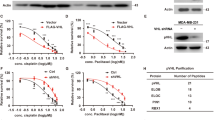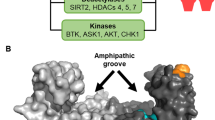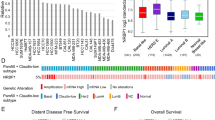Abstract
The 14-3-3σ (sigma) protein is a human cancer marker downregulated in various tumors, but its function has not been fully established. 14-3-3σ is a negative regulator of cell cycle when overexpressed, but it is not clear whether 14-3-3σ regulates cyclin-dependent kinase inhibitor p27Kip1 to negatively affect cell cycle progression. Protein kinase B/Akt is a crucial regulator of oncogenic signal and can phosphorylate p27Kip1 to enhance p27Kip1degradation, thereby promoting cell growth. Here, we show that 14-3-3σ-mediated cell cycle arrest concurred with p27Kip1 upregulation and Akt inactivation. We show that 14-3-3σ blocks Akt-mediated acceleration of p27Kip1 turnover rate. 14-3-3σ inhibits Akt-mediated p27Kip1 phosphorylation that targets p27Kip1 for nuclear export and degradation. 14-3-3σ inhibits cell survival and tumorigenicity of Akt-activating breast cancer cell. Low expression of 14-3-3σ in human primary breast cancers correlates with cytoplasmic location of p27Kip1. These data provide an insight into 14-3-3σ activity and rational cancer gene therapy by identifying 14-3-3σ as a positive regulator of p27 and as a potential anticancer agent.
This is a preview of subscription content, access via your institution
Access options
Subscribe to this journal
Receive 50 print issues and online access
$259.00 per year
only $5.18 per issue
Buy this article
- Purchase on Springer Link
- Instant access to full article PDF
Prices may be subject to local taxes which are calculated during checkout







Similar content being viewed by others
References
Aitken A . (1995). Trends Biochem Sci 20: 95–97.
Albertsen HM, Smith SA, Mazoyer S, Fujimoto E, Stevens J, Williams B et al. (1994). Nat Genet 7: 472–479.
Aprelikova O, Pace AJ, Fang B, Koller BH, Liu ET . (2001). J Biol Chem 276: 25647–25650.
Brunet A, Bonni A, Zigmond MJ, Lin MZ, Juo P, Hu LS et al. (1999). Cell 96: 857–868.
Carrano AC, Eytan E, Hershko A, Pagano M . (1999). Nat Cell Biol 1: 193–199.
Chan TA, Hermeking H, Lengauer C, Kinzler KW, Vogelstein B . (1999). Nature 401: 616–620.
Chen WS, Xu PZ, Gottlob K, Chen ML, Sokol K, Shiyanova T et al. (2001). Genes Dev 15: 2203–2208.
Datta SR, Katsov A, Hu L, Petros A, Fesik SW, Yaffe MB et al. (2000). Mol Cell 6: 41–51.
Dellambra E, Golisano O, Bondanza S, Siviero E, Lacal P, Molinari M et al. (2000). J Cell Biol 149: 1117–1130.
Diehl JA, Cheng M, Roussel MF, Sherr CJ . (1998). Genes Dev 12: 3499–3511.
Feng J, Park J, Cron P, Hess D, Hemmings BA . (2004). J Biol Chem 279: 41189–41196, E-pub 2004 Jul 15).
Ferguson AT, Evron E, Umbricht CB, Pandita TK, Chan TA, Hermeking H et al. (2000). Proc Natl Acad Sci USA 97: 6049–6054.
Fu H, Subramanian RR, Masters SC . (2000). Annu Rev Pharmacol Toxicol 40: 617–647.
Fujita N, Sato S, Katayama K, Tsuruo T . (2002). J Biol Chem 277: 28706–28713.
He TC, Zhou S, da Costa LT, Yu J, Kinzler KW, Vogelstein B . (1998). Proc Natl Acad Sci USA 95: 2509–2514.
Hermeking H, Lengauer C, Polyak K, He TC, Zhang L, Thiagalingam S et al. (1997). Mol Cell 1: 3–11.
Huang P, Feng L, Oldham EA, Keating MJ, Plunkett W . (2000). Nature 407: 390–395.
Ishida N, Kitagawa M, Hatakeyama S, Nakayama K . (2000). J Biol Chem 275: 25146–25154.
Kops GJ, de Ruiter ND, De Vries-Smits AM, Powell DR, Bos JL, Burgering BM . (1999). Nature 398: 630–634.
Laronga C, Yang HY, Neal C, Lee MH . (2000). J Biol Chem 275: 23106–23112.
Lee MH, Reynisdottir I, Massague J . (1995). Genes Dev 9: 639–649.
Lee MH, Yang HY . (2001). Cell Mol Life Sci 58: 1907–1922.
Liang J, Zubovitz J, Petrocelli T, Kotchetkov R, Connor MK, Han K et al. (2002). Nat Med 8: 1153–1160.
Medema RH, Kops GJ, Bos JL, Burgering BM . (2000). Nature 404: 782–787.
Miki Y, Swensen J, Shattuck-Eidens D, Futreal PA, Harshman K, Tavtigian S et al. (1994). Science 266: 66–71.
Newman L, Xia W, Yang HY, Sahin A, Bondy M, Lukmanji F et al. (2001). Mol Carcinogen 30: 169–175.
Prasad GL, Valverius EM, McDuffie E, Cooper HL . (1992). Cell Growth Differ 3: 507–513.
Sarbassov DD, Guertin DA, Ali SM, Sabatini DM . (2005). Science 307: 1098–1101.
Scheid MP, Woodgett JR . (2001). Nat Rev Mol Cell Biol 2: 760–768.
Sekimoto T, Fukumoto M, Yoneda Y . (2004). EMBO J 23: 1934–1942. E-pub 2004 Apr 1).
Shin I, Yakes FM, Rojo F, Shin NY, Bakin AV, Baselga J et al. (2002). Nat Med 8: 1145–1152.
Viglietto G, Motti ML, Bruni P, Melillo RM, D'Alessio A, Califano D et al. (2002). Nat Med 8: 1136–1144.
Vivanco I, Sawyers CL . (2002). Nat Rev Cancer 2: 489–501.
Wu X, Senechal K, Neshat MS, Whang YE, Sawyers CL . (1998). Proc Natl Acad Sci USA 95: 15587–15591.
Yaffe MB, Rittinger K, Volinia S, Caron PR, Aitken A, Leffers H et al. (1997). Cell 91: 961–971.
Yang H, Wen YY, Zhao R, Lin YL, Fournier K, Yang HY et al. (2006a). Cancer Res, in press.
Yang H, Zhao R, Lee MH . (2006b). Mol Cancer Ther, in press.
Yang HY, Shao R, Hung MC, Lee MH . (2001). Oncogene 20: 3695–3702.
Yang HY, Wen YY, Chen CH, Lozano G, Lee MH . (2003). Mol Cell Biol 23: 7096–7107.
Yang HY, Yang H, Zhao R, Lee MH . (2006). J Cell Biochem, in press.
Yarden RI, Pardo-Reoyo S, Sgagias M, Cowan KH, Brody LC . (2002). Nat Genet 30: 285–289. E-pub 2002 Feb 11).
Zhang Y, Yang HY, Zhang XC, Yang H, Tsai M, Lee MH . (2004). Oncogene 23: 7132–7143.
Zhou BP, Liao Y, Spohn B, Lee M-H, Hung M-C . (2001a). Nat Cell Biol 3: 245–252.
Zhou BP, Liao Y, Xia W, Zou Y, Spohn B, Hung MC . (2001b). Nat Cell Biol 3: 973–982.
Acknowledgements
We thank Drs Vogelstein and Hung for valuable reagents, and Drs Lozano, Legerski and Behringer for critical reading and comments. This work was supported by the NIHRO1CA (089266) and Cancer Center Core Grant (CA16672). M-H Lee is a recipient of the Flemin and Davenport research award and the Susan G Koman Breast Cancer Foundation research award.
Author information
Authors and Affiliations
Corresponding author
Rights and permissions
About this article
Cite this article
Yang, H., Zhang, Y., Zhao, R. et al. Negative cell cycle regulator 14-3-3σ stabilizes p27 Kip1 by inhibiting the activity of PKB/Akt. Oncogene 25, 4585–4594 (2006). https://doi.org/10.1038/sj.onc.1209481
Received:
Revised:
Accepted:
Published:
Issue Date:
DOI: https://doi.org/10.1038/sj.onc.1209481
Keywords
This article is cited by
-
Correlation of constitutive photomorphogenic 1 (COP1) and p27 tumor suppressor protein expression in ovarian cancer
Genes & Genomics (2019)
-
RBL2/p130 is a direct AKT target and is required to induce apoptosis upon AKT inhibition in lung cancer and mesothelioma cell lines
Oncogene (2018)
-
Cyclin-dependent kinase inhibitors, p16 and p27, demonstrate different expression patterns in thymoma and thymic carcinoma
General Thoracic and Cardiovascular Surgery (2014)
-
New pyrazolo[3,4-d]pyrimidine SRC inhibitors induce apoptosis in mesothelioma cell lines through p27 nuclear stabilization
Oncogene (2012)
-
Anticancer Effect of Celecoxib via COX-2 Dependent and Independent Mechanisms in Human Gastric Cancers Cells
Digestive Diseases and Sciences (2009)



